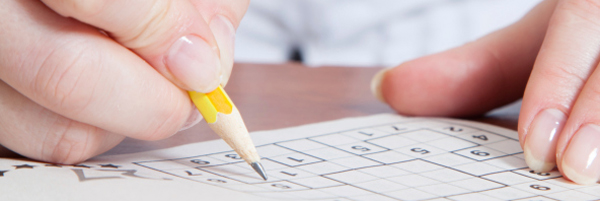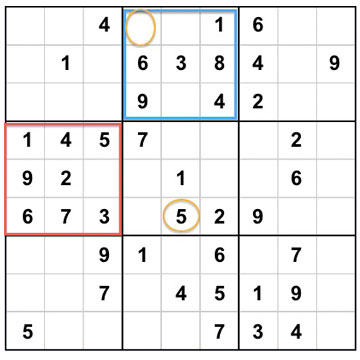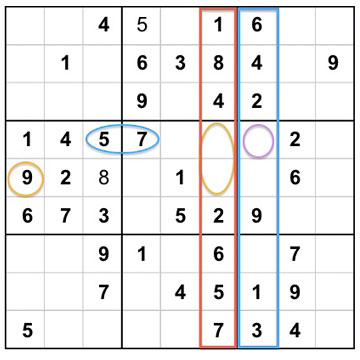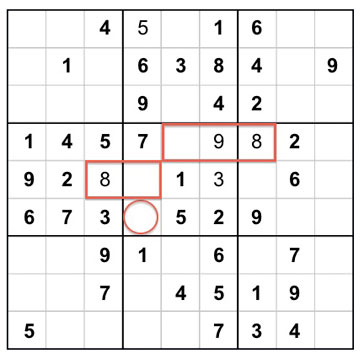Sudoku Strategy for Beginners

Fortunately, Sudoku is less complicated than it might appear at first. If you know how to approach the Sudoku grid and find a few shortcuts, you’ll start to quickly recognize the patterns in the game and figure out how to spot opportunities to successfully place numbers.
Here are a few tips on Sudoku strategy for beginners:
Look for Easy Opportunities First
Every Sudoku grid, when you start the game, comes with some numbers already placed into their correct spaces. This can give you an important head start for completing the rest of the puzzle. When you first start playing a new game of Sudoku, look to see where there are already lots of numbers placed – within a row, column or square. Sometimes the grid will do some of the work for you!

For example, in this puzzle, the square outlined in red already has 8 of the 9 numbers in place. This makes it easy to place the 9th remaining number (just by checking to see which number is missing). In this case, the red-outlined square is missing number 8. So we know already – without doing anything else – that number 8 can be placed in that space.
At the same time, when you look at the top center square outlined in blue, there are only 3 numbers left to be placed – numbers 2, 5 and 7.
By looking to the squares below, we can see a number 5 (circled in orange) in the center column – this means that those two empty spaces in the center column of the top (blue) square CANNOT contain number 5 – so the one remaining empty space in the blue square (upper left corner, circled in orange) must contain the number 5. Already, just by looking at some squares that already had a lot of numbers placed, we can fill in some gaps in the grid.
Look to Neighboring Rows
Sudoku is a game of recognizing patterns and spotting opportunities. Over time, you’ll get better and faster and noticing when it’s safe to eliminate certain numbers from consideration – but for Sudoku beginners, the best strategy when you are trying to fill an empty space is to keep scanning through neighboring rows and columns.
For example, in this grid below, the red column has two empty spaces (circled in orange). We know just by checking the other numbers in the red column that the only numbers remaining to be placed are 9 and 3. If we look to the left to see where other numbers might be, we can see a 9 in the center row of the left center square (circled in orange).

Now we know that the lower empty space in the red column CANNOT contain a number 9 – so it must be a 3, and the 9 must go in the upper empty space.
Similarly, if you look at the blue column, it has 6 out of 9 spaces filled. Just by scanning through the numbers that are already placed, we know that the only missing numbers are 5, 7 and 8. If you look to the left, you can see the numbers 5 and 7 in the same row with the empty space that is circled in purple. By process of elimination, we know that this purple space CANNOT contain 5 or 7, so it must contain number 8.
Follow Your Momentum
Sudoku is a game of momentum – every time you place a new number, try to follow up on it and keep the momentum going by looking to see what other numbers can be placed. Every time you place a number on the grid, the grid changes and new possibilities are revealed.
For example, in this grid, the central square only has three empty spaces remaining, and we know by checking the numbers that 4, 6 and 8 still need to be placed.

As described in the tips above, we have recently placed number 8s in the squares next to the upper right corner and left column of the central square (outlined in red).
This means that we can eliminate 8 from those two empty squares, and we know that number 8 needs to be placed in the lower left corner space of the central square (circled in red).
Once we place the number 8, we can look to eliminate number 4 and 6 – and if we look to the top row of the left center square, we can see number 4, so we know that the top empty space of the center square CANNOT contain number 4. Simple process of elimination will lead us to be able to complete the rest of the center square – and each new number that gets placed in that square will also have an impact on the surrounding squares, rows and columns. Every number placed into its correct spot brings us closer to solving the puzzle.